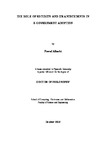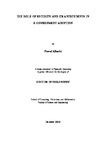The role of security and its antecedents in e-government adoption
| dc.contributor.supervisor | Papadaki, Maria | |
| dc.contributor.author | Alharbi, Nawaf Sulaiman S | |
| dc.contributor.other | School of Engineering, Computing and Mathematics | en_US |
| dc.date.accessioned | 2016-11-10T16:07:46Z | |
| dc.date.available | 2016-11-10T16:07:46Z | |
| dc.date.issued | 2016 | |
| dc.date.issued | 2016 | |
| dc.identifier | 10294651 | en_US |
| dc.identifier.uri | http://hdl.handle.net/10026.1/6703 | |
| dc.description | Full version: Access restricted permanently due to 3rd party copyright restrictions. Restriction set on 11.11.2016 by SC, Graduate School | |
| dc.description.abstract |
The use of e-government has increased in recent years, and many countries now use it to provide high quality services to their citizens. As user acceptance is crucial for the success of any IT project, a number of studies have investigated the user acceptance of e-government via the use of adoption models, such as the Unified Theory of Acceptance and Use of Technology (UTAUT) model. However, these models do not pay sufficient attention to security. The lack of security is one of the key issues associated with the adoption of e-government. Thus, this study aims at investigating the role of security in the behaviour intention for using e-government services. In addition, this study seeks to determine the factors influencing end users’ perceptions in e-government security. Therefore, in mind of achieving the aim, the research followed a mixed-methods approach, which divided the research into two phases. The first phase is a qualitative study aiming at exploring the factors influencing end users’ perceptions in e-government security. The second phase is a quantitative study aiming at identifying the role of security and its antecedences in the behaviour intention for using e-government services. To achieve this goal, a research model was developed by integrating trust, security and privacy with the UTAUT2 and tested via Structural Equation Modelling (SEM). The findings show that user interface quality, security culture and cyber-security law positively affect security perception. These factors explain 54% of security perception variance and strongly influence trust in e-government services. The findings also show that trust is ranked as the third most critical factor affecting behaviour intention after performance expectance and habit. The results make a significant contribution to academic research as this research is the first that investigated the factors that influence the security perception in e-government services. This will provide opportunities for further research to investigate further contributing factors and validate the security antecedences explored in this study. This research has practical implications regarding understanding the role of security in e-government adoption and the factors affecting end users’ perceptions of e-government security. This will help the decision makers in government to increase users’ trust in e-government by focusing more on these factors. | en_US |
| dc.language.iso | en | |
| dc.publisher | University of Plymouth | |
| dc.rights | CC0 1.0 Universal | * |
| dc.rights.uri | http://creativecommons.org/publicdomain/zero/1.0/ | * |
| dc.subject | Behaviour Intention | |
| dc.subject | Security perception | |
| dc.subject | Security antecedents | |
| dc.subject | UTAUT2 | |
| dc.subject | E-government | en_US |
| dc.subject.classification | PhD | en_US |
| dc.title | The role of security and its antecedents in e-government adoption | en_US |
| dc.type | Thesis | |
| plymouth.version | non-publishable | en_US |
| dc.identifier.doi | http://dx.doi.org/10.24382/386 | |
| dc.type.qualification | Doctorate | en_US |
| rioxxterms.funder | Not available | en_US |
| rioxxterms.identifier.project | Not available | en_US |
| rioxxterms.version | NA |
Files in this item
This item appears in the following Collection(s)
-
01 Research Theses Main Collection
Research Theses Main




